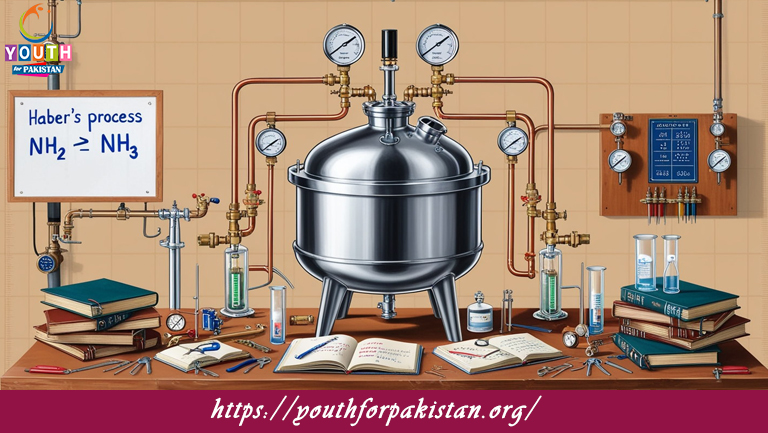Synthesis Of Ammonia By Haber’s Process MDCAT MCQs

Welcome to the Synthesis Of Ammonia By Haber’s Process MDCAT MCQs with Answers. In this post, we have shared Synthesis Of Ammonia By Haber’s Process Multiple Choice Questions and Answers for PMC MDCAT 2024. Each question in MDCAT Chemistry offers a chance to enhance your knowledge regarding Synthesis Of Ammonia By Haber’s Process MCQs in this MDCAT Online Test.
The primary reaction in the Haber process for ammonia synthesis is:
a) N₂ + 3H₂ → 2NH₃
b) N₂ + H₂ → NH₃
c) 2N₂ + 6H₂ → 2NH₃
d) N₂ + 2H₂ → NH₃
The Haber process operates at high pressure typically around:
a) 1 atm
b) 10 atm
c) 200 atm
d) 1000 atm
The temperature used in the Haber process is approximately:
a) 25°C
b) 100°C
c) 300°C
d) 450°C
The catalyst used in the Haber process is:
a) Iron
b) Nickel
c) Platinum
d) Copper
The purpose of increasing the pressure in the Haber process is to:
a) Increase the rate of reaction
b) Increase the yield of ammonia
c) Decrease the temperature
d) Enhance the catalyst activity
The Haber process is named after:
a) Fritz Haber
b) Carl Bosch
c) Wilhelm Ostwald
d) Paul Sabatier
In the Haber process, what is the role of the catalyst?
a) To increase the pressure
b) To increase the temperature
c) To lower the activation energy
d) To remove impurities
The Haber process is an example of a:
a) Exothermic reaction
b) Endothermic reaction
c) Isothermal reaction
d) Reversible reaction
Which of the following is a byproduct of the Haber process?
a) Nitrogen dioxide
b) Carbon dioxide
c) Hydrogen sulfide
d) None
The reaction of nitrogen and hydrogen in the Haber process is:
a) Irreversible
b) Reversible
c) Spontaneous
d) Non-reversible
The Haber process was industrially developed by:
a) Fritz Haber and Carl Bosch
b) Wilhelm Ostwald and Paul Sabatier
c) Fritz Haber and Paul Sabatier
d) Carl Bosch and Wilhelm Ostwald
The optimal pressure for the Haber process is around:
a) 10-50 atm
b) 100-200 atm
c) 200-300 atm
d) 400-500 atm
The Haber process primarily produces:
a) Methanol
b) Ammonia
c) Ethylene
d) Hydrogen chloride
In the Haber process, what is the function of the iron catalyst?
a) To absorb excess heat
b) To increase the concentration of ammonia
c) To facilitate the breaking of nitrogen-hydrogen bonds
d) To remove nitrogen from the reaction mixture
The Haber process is carried out in which type of reactor?
a) Batch reactor
b) Continuous flow reactor
c) Plug flow reactor
d) Stirred tank reactor
The equilibrium constant for the Haber process:
a) Increases with temperature
b) Decreases with temperature
c) Remains constant with temperature
d) Is not affected by temperature
The addition of which substance is essential to the Haber process to maintain pressure?
a) Argon
b) Carbon dioxide
c) Oxygen
d) Nitrogen
In the Haber process, hydrogen is typically obtained from:
a) Electrolysis of water
b) Steam reforming of methane
c) Decomposition of ammonia
d) Combustion of hydrocarbons
The Haber process is essential for producing which type of fertilizer?
a) Nitrogen-based fertilizers
b) Phosphate fertilizers
c) Potassium fertilizers
d) Calcium fertilizers
The role of temperature in the Haber process is to:
a) Increase the rate of reaction
b) Decrease the yield of ammonia
c) Increase the solubility of nitrogen
d) Decrease the concentration of hydrogen
The Haber process utilizes which gas as a reactant?
a) Methane
b) Carbon monoxide
c) Hydrogen
d) Oxygen
What is the main advantage of the Haber process?
a) High yield of ammonia
b) Low energy consumption
c) Production of pure hydrogen
d) Reduction of carbon emissions
The Haber process is an example of which type of chemical reaction?
a) Addition reaction
b) Decomposition reaction
c) Substitution reaction
d) Combination reaction
The Haber process has led to significant advancements in:
a) Pharmaceuticals
b) Agriculture
c) Energy production
d) Textile manufacturing
What happens to the ammonia produced in the Haber process?
a) It is stored as a gas
b) It is used directly in fertilizers
c) It is converted to nitrogen and hydrogen
d) It is disposed of as a byproduct
The Haber process is a crucial step in the production of:
a) Sulfuric acid
b) Methanol
c) Ammonium nitrate
d) Ethanol
Which of the following factors does NOT affect the yield of ammonia in the Haber process?
a) Pressure
b) Temperature
c) Catalyst
d) Color of the reactor
The equilibrium position in the Haber process is shifted by:
a) Increasing temperature
b) Decreasing pressure
c) Removing ammonia as it forms
d) Adding more nitrogen
The efficiency of the Haber process is increased by:
a) Using a higher catalyst concentration
b) Lowering the temperature
c) Using a lower pressure
d) Adding more hydrogen
The ideal gas law is used to calculate the:
a) Rate of ammonia production
b) Pressure of the reaction mixture
c) Temperature of the reactor
d) Volume of gases involved
What is the primary source of nitrogen used in the Haber process?
a) Air
b) Natural gas
c) Coal
d) Water
The reaction in the Haber process is an example of:
a) Exothermic reaction
b) Endothermic reaction
c) Isothermal reaction
d) Adiabatic reaction
The Haber process has greatly contributed to:
a) Industrial synthesis of hydrogen
b) Increased agricultural productivity
c) Reduction of greenhouse gases
d) Development of new materials
In the Haber process, the recycling of unreacted gases is:
a) Not necessary
b) Essential for efficiency
c) Done to remove impurities
d) Used to cool the reactor
The catalyst in the Haber process is promoted by:
a) Sulfur
b) Potassium
c) Aluminum
d) Calcium
Which parameter is adjusted to shift the equilibrium towards ammonia formation in the Haber process?
a) Temperature
b) Pressure
c) Volume
d) Concentration of nitrogen
The use of a catalyst in the Haber process:
a) Increases the equilibrium yield of ammonia
b) Increases the rate of reaching equilibrium
c) Reduces the cost of raw materials
d) Lowers the temperature required for the reaction
Which of the following gases is NOT used in the Haber process?
a) Nitrogen
b) Hydrogen
c) Argon
d) Carbon dioxide
The Haber process primarily contributes to:
a) Medicine
b) Energy production
c) Food supply
d) Transportation
The production of ammonia by the Haber process is crucial for:
a) Producing synthetic fibers
b) Generating electricity
c) Creating pharmaceuticals
d) Making explosives
If you are interested to enhance your knowledge regarding Physics, Chemistry, Computer, and Biology please click on the link of each category, you will be redirected to dedicated website for each category.





